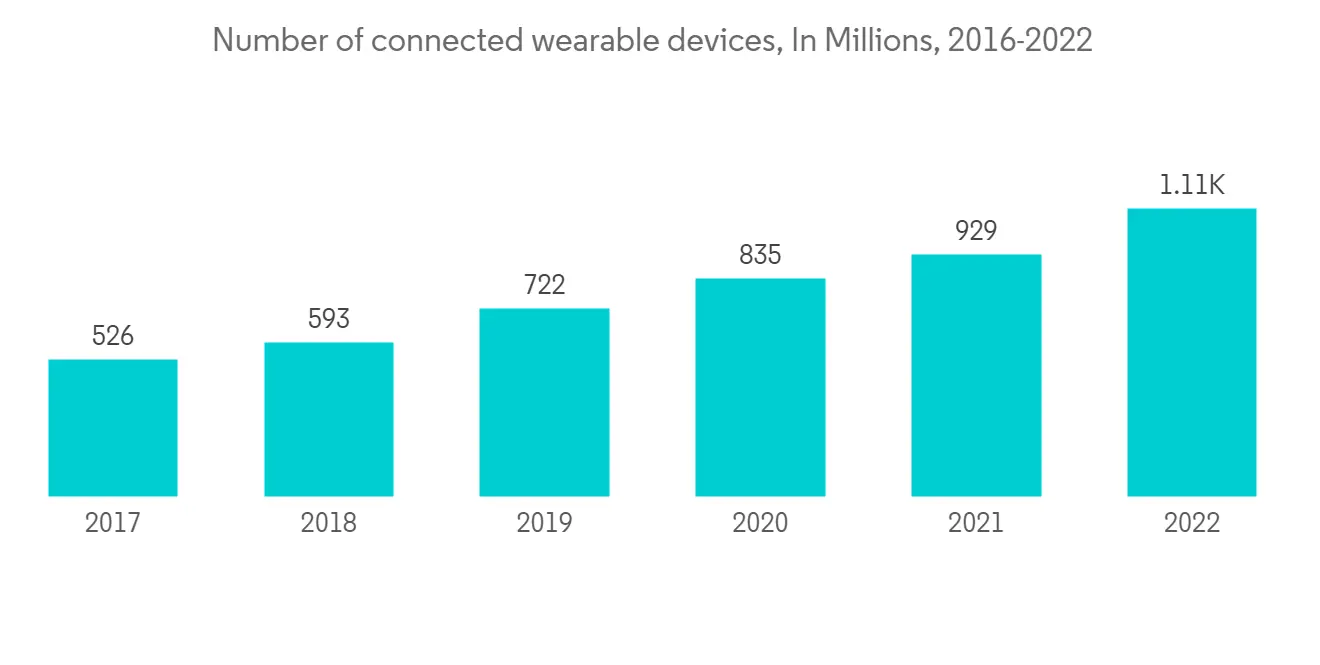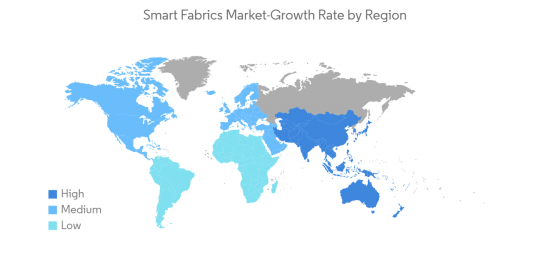 |
市場調查報告書
商品編碼
1329885
智能織物市場規模/份額分析 - 增長趨勢和預測(2023-2028)Smart Fabrics Market Size & Share Analysis - Growth Trends & Forecasts (2023 - 2028) |
||||||
※ 本網頁內容可能與最新版本有所差異。詳細情況請與我們聯繫。
智能織物市場規模預計將從2023年的614萬套擴大到2028年的1027萬套,預測期內(2023-2028年)複合年增長率為10.85%。
智能紡織品是為了集成為用戶提供增強功能的技術而製造和設計的紡織品。 近年來,基於可穿戴紡織品的個人系統的研究和開發,例如健康監測、防護和安全以及健康生活方式,引起了人們的極大興趣。 最近,麻省理工學院(MIT)開發了智能服裝,可以追蹤人類健康最重要的指標:心率、呼吸頻率和體溫。 這是通過縫製一個高度敏感的傳感器來實現的,該傳感器將皮膚貼合到織物中。
主要亮點
- 可穿戴電子行業的增長正在推動市場發展。 各個最終用戶行業對智能可穿戴設備的需求不斷增長是推動智能織物市場增長的主要因素。 人們正在努力擴大紡織可穿戴設備的支付能力。 萬事達卡 (Mastercard) 與 Timex 合作,將非接觸式支付集成到其手錶中。 一旦這些出色的應用成為主流,市場可能會發生變化,以適應智能織物的類似趨勢。
- 電子產品的小型化和柔性電子產品的發展正在推動市場發展。 傳感器、執行器(用於主動智能紡織品)和控制單元(用於高級智能紡織品)等微型電子產品的進步正在提高智能織物的效率。 在多功能塑料製造、納米級製造和印刷電子領域可以找到重要的專業知識。 例如,麻省大學洛厄爾分校開發柔性電子產品和智能紡織品,並有正在進行的研究項目。 我們正在開發高頻印刷共形天線、碳基晶體管、光子器件,並研究軍用可穿戴天線。
- 此外,纖維、線和紡織品形式的可穿戴摩擦納米發電機的開發正在推動研究目標市場的顯著發展。 這些納米發電機在與超級電容器、鋰電池、太陽能電池等器件有效集成時,證明了其實現自充電可穿戴系統的可行性,並引起了智能可穿戴設備的關注。
- 例如,紡織品製造公司 Nextiles 最近憑藉可記錄生理和生物力學數據的智能紗線技術進入了運動表現行業。 Nextiles 通過將傳統縫紉方法與印刷電路板相結合,為日常運動服打造柔性面料。 得益於一項專利製造技術,NexChilds 織物能夠在一個平台上記錄生物力學和生物識別傳感。
- 此外,由於新冠肺炎 (COVID-19) 疫情的爆發,市場不會出現顯著增長。 智能織物的生產需要高度自動化,需要電子控制系統、計算機輔助設計和自動化檢測等紡織加工技術的進步。 該行業屬於"服裝和家居用品"類別,因此不屬於基本服務領域,因此工廠目前尚未運營。
智能面料市場趨勢
時尚和娛樂行業經歷顯著增長
時尚和娛樂行業利用智能面料為服裝帶來獨特的美感。 服裝的顏色、尺寸和形狀等外觀特徵可以通過織入織物的技術來改變。 服裝中的智能面料允許用戶與周圍環境進行交互,並通過嵌入式傳感器和導電線通過可穿戴設備所穿的衣服來傳輸數據。
在時尚行業,設計師通過創新設計出美觀的新服裝,並與可傳遞信息的便捷技術架構相結合,正在推動所研究的市場。 包括優衣庫和露露檸檬在內的許多品牌都在以智能材料引領其產品系列。
Under Armour、Levi's 和 Tommy Hilfiger 等許多知名品牌,以及 Sensola、Lumia、Hexoskin 和 Cute Circuit 等小型企業,都在使用智能面料提供智能服裝,並領先於其他公司開發系列.做。 例如,CuteCircuit 在其高級時裝系列和特殊項目中使用智能材料。 CuteCircuit的"擁抱襯衫"可以通過衣服內的傳感器向用戶發送電子擁抱。
法國初創公司 Spinali Design 生產的豪華沙灘裝配有內置紫外線傳感器,可以告知何時需要塗抹防曬霜,還配有距離追蹤器,可以讓父母知道孩子何時離水邊太近。
此外,在過去幾年中,Google 一直在 Project Jacquard 下與 Levi Strauss & Co. 合作開發未來的智能牛仔夾克。

北美佔據主要市場份額
北美預計將在智能面料市場中佔據較大份額,其中美國占據主要份額。 聯網可穿戴產品是一個大趨勢,有多種形式,包括健身手環、智能手錶和智能眼鏡。
此類可穿戴電子設備的日益普及預計將為智能織物市場開闢新的途徑,因為它顯著提高了人類的舒適度、健康和福祉。
此外,加拿大武裝部隊在其 IAV Striker 裝置上採用了全織物鍵盤。 它的設計更輕,攜帶更舒適,並且易碎部件更少。
此外,智能織物開發的研究水平在該地區領先一步。 該地區正在進行研究和開發,以創造適應性冬季服裝,幫助控制每個人周圍的微氣候。 例如,OtherLab 的衍生公司 Kestrel Materials 將基於纖維雙壓電晶片結構的熱自適應服裝技術商業化,該結構具有戰略上不匹配的熱膨脹係數。
2022 年 7 月,麻省理工學院 (MIT) 的研究人員採用創新製造工藝開發出一種可感知穿著者位置和動作的身體自適應智能織物。 通過集成和熱成型特定類型的塑料線,研究團隊能夠顯著提高編織到稱為 3DKnITS 的多層針織紡織品中的壓力傳感器的精度。 該方法被用來開發"智能"鞋子和墊子,並開發了硬件和軟件系統來實時收集和分析來自壓力傳感器的數據。 機器學習算法可以預測人站在智能紡織墊上時的動作和瑜伽姿勢,準確率約為 95%。

智能紡織行業概述
由於多家供應商最近籌集了資金並將其投入生產,智能織物市場呈現碎片化。 例如,Zenoma 通過 AOKI 和 Toyoshima 的額外投資籌集了資金。 此類案例助長了市場競爭。 此外,在考慮集成商級別的利益相關者時,可以看到前向集成。 Hexoskin 和 Sensoria 等公司正在加劇針對最終消費者的可製造性的競爭。 近期市場動態如下。
2022 年 7 月,總部位於加利福尼亞州卡爾弗城的 Loomia Technologies 與美國高級功能面料 (AFFOA) 合作,為商業、休閒和軍事客戶打造高觸感面料。我們生產加熱手套。 AFFOA 引領消費者發現,提供架構系統設計並創建界面控制單元,而 Loomia 則提供其創新的電子紡織品技術,並為實現加熱手飾做出貢獻。Masu。
其他好處:
- Excel 格式的市場預測 (ME) 表
- 3 個月的分析師支持
目錄
第1章簡介
- 研究假設和市場定義
- 調查範圍
第2章研究方法
第 3 章執行摘要
第 4 章市場動態
- 市場概覽
- 行業吸引力 - 波特五力分析
- 供應商的議價能力
- 消費者議價能力
- 新進入者的威脅
- 競爭公司之間的對抗關係
- 替代品的威脅
- 行業價值鏈分析
- 評估新冠肺炎 (COVID-19) 對行業的影響
第五章市場動態
- 市場驅動因素
- 可穿戴電子行業的增長
- 電子產品的小型化和柔性電子產品的開發
- 市場挑戰
- 對高成本和數據安全的擔憂
第6章市場細分
- 類型
- 無源智能織物
- 活性面料
- 超智能面料
- 應用
- 時尚和娛樂
- 運動與健身
- 醫療
- 交通/其他
- 太空/軍事
- 行業
- 地區
- 北美
- 亞太地區
- 歐洲
- 世界其他地區
第七章競爭格局
- 公司簡介
- AIQ Smart Clothing Inc.
- Adidas AG
- NIKE Inc.
- ThermoSoft International Corporation
- Kolon Industries Inc.
- Interactive Wear AG
- Ohmatex
- Schoeller Textil AG
- Sensoria Inc.
- OTEX Specialty Narrow Fabrics Inc.
第8章 投資分析
第9章 市場機會與今後動向
The Smart Fabrics Market size is expected to grow from 6.14 million units in 2023 to 10.27 million Units by 2028, at a CAGR of 10.85% during the forecast period (2023-2028).
Smart textiles are fabrics that are manufactured and designed to integrate technologies that offer the user increased functionality. R&D toward wearable textile-based personal systems, such as health monitoring, protection and safety, and healthy lifestyles, gained major interest over the last few years. Recently, MIT developed smart clothing that follows the most important indicators of human health, i.e., heart rate, respiratory rate, and temperature. This was achieved by sewing into the fabric of sensitive sensors that fit the skin.
Key Highlights
- The growth in the wearable electronics industry is driving the market. The growing demand for smart wearables across various end-user industries is the major factor driving the growth of the smart fabric market. A significant amount of effort is witnessed to expand what fabric wearables can do with respect to payments. Mastercard partnered with Timex to integrate contactless payments into their watches, while a U.K.-based CashCuff did the same with the cufflinks. When such distinguished applications become mainstream, which it has, the market is very likely to shift to accommodate similar trends in smart fabrics.
- Miniaturization of electronics and developments across flexible electronics is driving the market. The efficiency of smart fabrics is enhancing with the advancement in miniaturized electronic items, such as sensors, actuators (for active smart textiles), and controlling units (advanced smart textiles). Significant expertise in multifunctional plastics manufacturing, nanoscale manufacturing, and printed electronics has been seen. For instance, UMass Lowell develops flexible electronics and smart textiles-some ongoing research projects. We are developing high-frequency printed conformal antennas, carbon-based transistors, and photonic devices and researching wearable antennas for the military.
- Further, the developments on wearable triboelectric nanogenerators in shapes of fiber, yarn, and textile enable a signficant development in the market studied. These nanogenerators, when effectively integrated with devices such as supercapacitor, lithium battery, and solar cell, their feasibility for realizing self-charging wearable systems have been proven to attract the attention of smart wearables.
- For instance, Nextiles, a textile manufacturing firm, recently entered the sports and performance industry with smart thread technology that records physiological and biomechanical data. The flexible cloth used in everyday sportswear was created by Nextiles by fusing conventional stitching methods with printed circuit boards. Nextiles' fabrics enable biomechanic and biometric sensing recorded on one platform owing to the patented production technique.
- Further, with the outbreak of COVID-19, the market did not experience substantial growth. This is because manufacturing smart fabric needed a high degree of automation and advancements in textile processing techniques such as electronic controlling system, computer-aided design, automated inspection, etc. The industry did not come under the essential services segment as it was considered in the "apparel and lifestyle goods" category, resulting from which factories were currently not under operations.
Smart Fabrics Market Trends
Fashion and Entertainment Industry to Witness Significant Growth
The fashion and entertainment industry uses smart fabrics to incorporate unique aesthetics into clothing. Appearance features, such as color, size, or shape of garments, can be altered using technology woven into fabrics. Smart fabrics in clothes enable the user to interact with their surroundings and communicate data via embedded sensors or conductive yarn through the clothes they wear with wearable devices.
In the fashion industry, the market studied is driven by innovations of the designers coming up with new and aesthetically pleasing outfits integrated with a useful technical architecture capable of relaying information. Many brands, including Uniqlo to Lululemon, use smart fabrics to set their collections ahead of the pack.
Many prominent brands such as Under Armour, Levi's, and Tommy Hilfiger, among others, along with smaller companies such as Sensora, Loomia, Hexoskin, CuteCircuit, are offering their smart clothing that are using smart fabrics to set their collections ahead of the others. For instance, CuteCircuit utilizes smart fabrics for its haute couture collections and special projects. CuteCircuit's 'Hug Shirt' allows the user to send electronic hugs through sensors within the garment.
The French startup Spinali Design makes high-end beachwear with integrated ultraviolet light sensors that tell the wearer when it's time to apply sunscreen and distance trackers that tells the parents when the kids have wandered too close to the surf.
Further, for the past few years, Google worked with Levi Straus on a future smart jean jacket under Project Jacquard, which would eventually lead to a jean jacket with smart fabric sleeves and built-in touch controls.

North America to Account for a Significant Market Share
North America is anticipated to substantiate a prominent share in the smart fabrics market, with the United States region accounting for the major share. Connected wearable products are gaining significant trends and have been around in various forms, such as fitness bands, smartwatches, smart glasses, and among others.
This increasing adoption of wearable electronics devices is anticipated to open new avenues for the smart fabrics market as they offer significant enhancements to human comfort, health, and well-being.
Furthermore, the Canadian military has used full-fabric keyboards in its IAV Stryker units, developed to replace the bulky, traditional hardware. These are designed to be lighter, more comfortable to transport, and have fewer components to break.
Moreover, the level of research for developing smart fabrics has taken a step ahead in the region. The region has been witnessing research and developments to create adaptive thermal clothing that could help control the microclimate around each individual. For instance, Kestrel Materials, an OtherLab spin-out company, commercializes thermally adaptive garment technology based on textile bimorph structure with strategically mismatched coefficients of thermal expansion.
In July 2022, MIT researchers developed smart fabrics that adapt to the body to sense the wearer's position and actions using an innovative production process. The researchers were able to significantly increase the precision of pressure sensors woven into multilayered knit textiles known as 3DKnITS by integrating a particular kind of plastic yarn and applying thermoforming. This method was utilized to develop a "smart" shoe and mat, and a hardware and software system was then developed to collect and analyze data from the pressure sensors in real time. With an accuracy rate of roughly 95%, the machine-learning algorithm anticipated the movements and yoga positions that a person would make while standing on the smart textile mat.

Smart Fabrics Industry Overview
The Smart Fabrics Market is fragmented because multiple vendors have been witnessed raising funding recently to be channelized onto productions. For instance, Xenoma raised funds through additional investment by AOKI and TOYOSHIMA. These instances cater to market rivalry. Further, forward integration has been witnessed when considering the integrator-level stakeholders. With companies like Hexoskin and Sensoria, the competition has risen concerning end-consumer manufacturability. Recent developments in the market are -
In July 2022, Loomia Technologies, based in Culver City, California, collaborated with Advanced Functional Fabrics of America (AFFOA) to produce highly tactile, heated handwear for commercial/recreational and military customers. AFFOA will lead consumer discovery, provide architectural system designs, and create an interface control unit, while Loomia will contribute its innovative e-textile technology to making heated handwear a reality.
Additional Benefits:
- The market estimate (ME) sheet in Excel format
- 3 months of analyst support
TABLE OF CONTENTS
1 INTRODUCTION
- 1.1 Study Assumptions and Market Definition
- 1.2 Scope of the Study
2 RESEARCH METHODOLOGY
3 EXECUTIVE SUMMARY
4 MARKET DYNAMICS
- 4.1 Market Overview
- 4.2 Industry Attractiveness - Porter's Five Forces Analysis
- 4.2.1 Bargaining Power of Suppliers
- 4.2.2 Bargaining Power of Consumers
- 4.2.3 Threat of New Entrants
- 4.2.4 Intensity of Competitive Rivalry
- 4.2.5 Threat of Substitute Products
- 4.3 Industry Value Chain Analysis
- 4.4 Assessment of Impact of COVID-19 on the Industry
5 MARKET DYNAMICS
- 5.1 Market Drivers
- 5.1.1 Growth in Wearable Electronics Industry
- 5.1.2 Miniaturization of Electronics and Developments across Flexible Electronics
- 5.2 Market Challenges
- 5.2.1 High Cost and Data Security Concerns
6 MARKET SEGMENTATION
- 6.1 Type
- 6.1.1 Passive Smart Fabrics
- 6.1.2 Active Fabrics
- 6.1.3 Ultra-smart Fabrics
- 6.2 Application
- 6.2.1 Fashion and Entertainment
- 6.2.2 Sports and Fitness
- 6.2.3 Medical
- 6.2.4 Transportation and Others
- 6.2.5 Space and Military
- 6.2.6 Industrial
- 6.3 Geography
- 6.3.1 North America
- 6.3.2 Asia Pacific
- 6.3.3 Europe
- 6.3.4 Rest of the World
7 COMPETITIVE LANDSCAPE
- 7.1 Company Profiles
- 7.1.1 AIQ Smart Clothing Inc.
- 7.1.2 Adidas AG
- 7.1.3 NIKE Inc.
- 7.1.4 ThermoSoft International Corporation
- 7.1.5 Kolon Industries Inc.
- 7.1.6 Interactive Wear AG
- 7.1.7 Ohmatex
- 7.1.8 Schoeller Textil AG
- 7.1.9 Sensoria Inc.
- 7.1.10 OTEX Specialty Narrow Fabrics Inc.











